Earthquakes: Collateral Effects
The energy released from an earthquake can be up to 10,000 times more powerful than the first atomic bomb. Its side-effects can be:
Ground shaking
Shaking of the ground caused by the passage of seismic waves, especially surface waves near the epicentre of the earthquake are responsible for the most damage during an earthquake. The intensity of ground shaking depends on:
- conditions of the local geology influence events: solid bedrock is far less subject to intense shaking than loose sediment;
- duration and intensity of the earthquake are subject generally to the size of the earthquake;
- distance: the distance from the epicentre drops off so the intensity of the shaking decreases. This depends on the type of material underlying the area. There are however some exceptions. The 1985 Earthquake in Mexico city (magnitude 8.1) had its epicentre 350 Km away to the south on the coast. Damage to city was extensive as Mexico city is built on a former lake made up of soft unconsolidated sediment (see: Liquefaction further down).
Faulting and Ground Rupture
When an earthquake event occurs, ground rupture is only where the fault zone moves. Those constructions built adjacent to the fault will survive while structures built across these zones will collapse.
Landslides and ground subsidence
Avalanches, landslides, slumps and rock slides are triggered by ground shaking. These landslides are often more destructive than the earthquakes. A residential area in Alaska (Turnagain Heights) was destroyed by a shock induced landslide as well as are in downtown Anchorage.
Damage to man-made structures
Damage to man-made structures, such as roads, bridges, dams and buildings from ground motion depends on the type of construction:
- concrete and masonry structures are brittle and thus more susceptible to damage and collapse;
- damage to wood and steel structures is far less because of its flexibility.
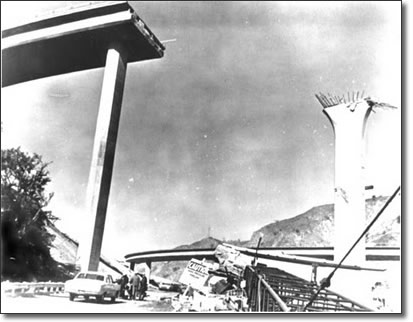
This aerial photograph of the San Fernando earthquake in Feb 1971 shows the extensive damage to the freeway bridge as the Earth's crust shook.
"Earthquakes don't kill people, buildings do". This quote is from Seismologists who believe that human construction and buildings crashing down during earthquakes are the cause of most deaths.
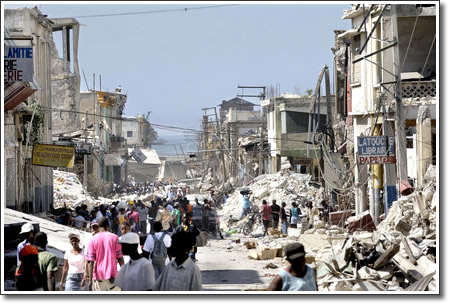
This photo shows the extreme danger presented by seismic shaking to people in the open around buildings and on the street. Complete facades of buildings, electric signage and windows crash and collapse onto the street below. It is known to be far safer to shelter under robust furniture than to run out onto the street.
Fires
Fires, often associated with broken electrical and gas lines, is one of the common side effects of earthquakes. Gas is set free as gas lines are broken and a spark will start bringing "inferno". To complicate things water lines are broken and so there is no water to extinguish the fire. The San Francisco earthquake of 1906 caused 90% of damage by fire.
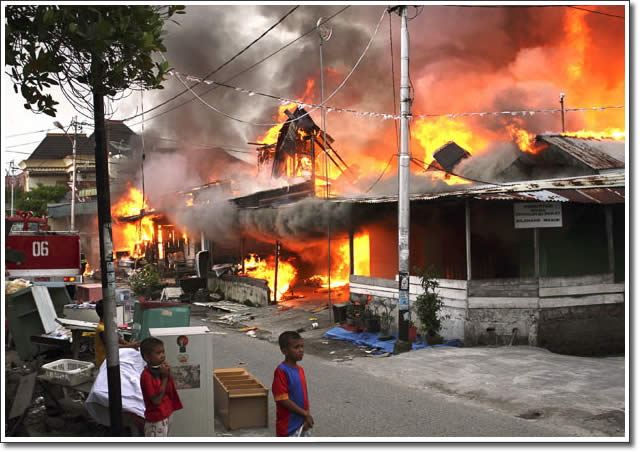
Spill of hazardous chemicals
Christchurch Earthquake (New Zealand, 2010): related article.
Kocaeli chemicals spill (Turkey, 1999): Case study report.
In the image above, some buildings toppled when the soil underwent liquefaction. Buildings can even sink into the ground if soil liquefaction occurs.
Flooding
Flooding can come from many sources such as broken water main pipes, dams that fail due to the earthquake and earthquake-generated tsunamis. When an earthquake breaks a dam or levee along a river, the water from the river or the reservoir floods the area, damaging buildings and maybe sweeping away or drowning people. Small tsunamis, called seiches occur on lakes shaken by earthquakes and are usually just a few feet high. These small tsunamis are capable of destroying houses and uprooting trees. Also, earthquakes can alter the course of a river and can even cause it to flow in the opposite direction for a short time (this happened to the Mississippi River in the late 1800's).
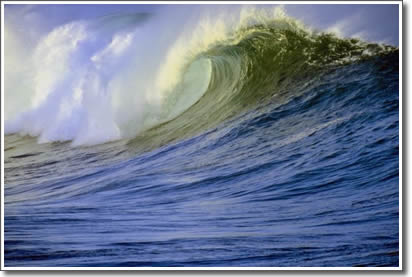
A seiche is the effect of the sloshing of water back and forth. A seiche can be caused by an earthquake and/or a tsunami. The earthquake from Alaska on March 28th, 1964 caused seismic waves that were so powerful that bodies of water oscillated in many places across North America. Hundreds of surface water gauging stations recorded seiches although rarely recorded before this earthquake.
Tsunamis
For sure, one of the most dangerous effects of an earthquake is a Tsunami. Tsunamis are giant waves that can cause floods and in some cases may reach up to 100 feet in height. These deadly waves strike a great distance from the epicentre. Tsunamis often result from sub-sea faulting of ocean floor sending seismic shocks through the water and creating large waves of low amplitude but of long period, moving at 500-700 mph.
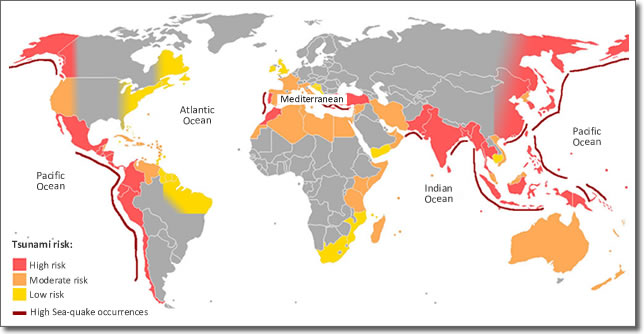
For You and Your Loved Ones
With preparedness and safety measures, protect yourself and your family from earthquake risks.
Always good to prepare for an earthquake
Earthquake Warnings are a Game Changer
Stay protected, anytime, anywhere

HAPPY CLIENTS
ALERTS DELIVERED SINCE 2011

